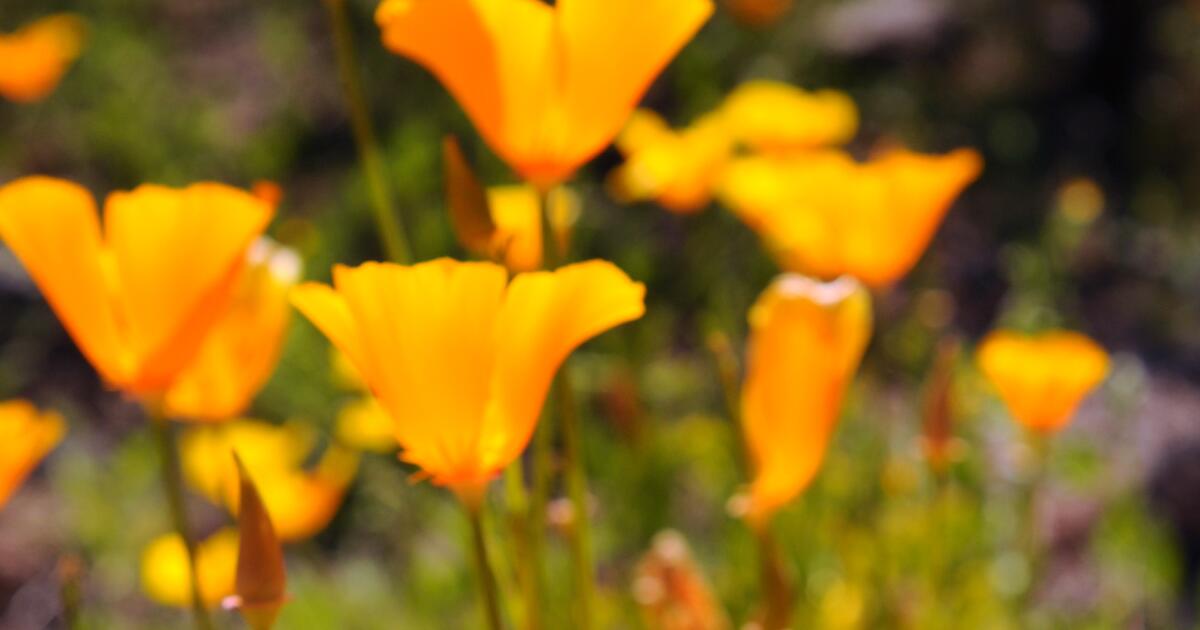
In our part of the world, fall is the busiest gardening season. The air is cool, the soil is warm and with the possibility of a powerful El Niño, we could be seeing generous rainfall through spring. These are San Diego’s ideal planting conditions!
Plan first
Find inspiration from photos of beautiful waterwise gardens in my latest book, “Hot Color, Dry Garden,” at waterwisegardener.com/books.
Before you head to the nursery, make a plan. A plan helps you save time and money, and ensures your most successful garden.
Make a drawing first, whether rough or fine. Use it as a reference as you plan what you’ll plant.
Measure your property with a tape measure or the measuring app on your smartphone. Plot it on grid paper (one grid square equals 1 square foot) or one of the many layout and graphic apps on your computer or tablet. This drawing becomes your “baseplan.”
Rather than draw on a paper baseplan, cover the baseplan with tracing paper and draw on the tracing paper in pencil. Or make a copy of your digital baseplan. Use that for your design.
Make sure the new plants fit the spaces available in your garden both in terms of height and width. Avoid common mistakes:
- A plant that grows to 10 feet wide planted in a 5-foot-wide space means the new plant will eventually grow into surrounding plants or pathways or structures.
- A plant that grows 12 feet tall sited in front of a low window soon blocks the view and light through the window. Instead, measure the space between the ground and where the window starts. Match that height to the mature plant height.
- Plants that grow wider and/or taller than what there’s room for dooms the plant — and you — to forever pruning. It wastes time, money, effort — and results in a plant that never grows to fulfill its potential.
- Keep trees and lawn separated. The two kinds of plants have completely different water needs. Trees planted in lawns develop shallow, weak roots. They also shade out and crowd out the grass below.
- Keep trees far from irrigation lines, sidewalks, foundations, driveways, etc. Find the sweet spot where the tree is close enough to shade your home, yet far enough that roots won’t cause problems. Find ratings of root damage potential at selectree.calpoly.edu.
For every plant on your plan, also know:
- How much sun or shade it requires.
- The kind of soil it does best in.
- How much irrigation it needs.
- Whether it is evergreen or deciduous (loses its leaves).
- Whether you have a spot that meets all of its needs. If not, choose something else.
Place vegetable gardens as close to your kitchen as possible, in full-day sun and where water is close by.
Don’t be intimidated by a steep slope; it’s just a garden at an angle. Plant it with a combination of trees, shrubs and low-growing plants. Those bigger, woody plants grow the deep roots that hold the slope in place.
Plant real plants, not artificial turf. Artificial turf does not mix well with actual living plants. It heats up as hot or hotter than asphalt, requires regular washing, releases microplastics into the environment, sprouts weeds and has none of the advantages of living plants. It wears out quickly and ends up in the landfill, even if it is labeled as “recyclable.” Landscape rebate programs do not permit artificial turf installations, and concerns about “forever chemicals” have cities across California banning its installation.
Don’t waste your money on landscape fabric, aka “weed cloth.” It does not stop weeds, but it does inhibit water penetration into the soil below, turning the soil hard as concrete and damaging the critically important beneficial organisms that plant roots count on for health and survival. Landscape fabric releases microplastics into the environment and eventually shreds. Within a few years, you’ll be tearing out what you installed. Landscape plastic is as bad or worse.
Once you have a baseplan and a planting plan, prepare your shopping list. Include the botanical name of each plant, its mature dimensions and how many you need.
Important: Buy small plants. While large plants are tempting, small plants adapt best to their new homes. They grow fastest and strongest, and outpace larger plants of the same kind within just a few years.
Shop at your local independent nursery. If they don’t have what you want in stock, ask them to order it for you.
Ornamentals
Treat roses as you treat stone fruits. Rake up and dispose of this year’s leaves, even those already fallen. Prepare to prune and spray in December and January.
If a seed mix has the term “wildflower” in its name, that doesn’t mean the seeds are native to our region. If you want California wildflowers, look for seeds such as California poppies, elegant clarkia (Clarkia unguiculata), large flowered phacelia, (Phacelia grandiflora), tidy tips (Laia platyglossa), baby blue eyes (Nemophila menziesii), California goldfields (Lasthenia californica), blue field gilia (Gilia capitata) and others.
How to plant annual wildflower seeds:
- Choose a spot in full sun.
- Make soil smooth, then water to saturate the soil.
- Put the seeds into a 1-pint plastic container, then add construction sand in a 1:4 ratio and mix.
- Sprinkle the seed-and-sand mix over the seedbed.
- Rake soil gently so seeds are just barely buried.
- Water again, with a very soft spray so the soil is wet enough to settle in around the seeds. Continue to water every few days (unless it rains) to keep the soil, seeds and young seedlings damp.
Add every kind of woody tree, shrub, perennial, vine, etc. to your garden now.
- California natives like lavender blooming chaparral mallow (Malacothamnus fasciculatus), yellow flowered bladder pod (Peritoma arborea), garden-sized scrub oak (Quercus berberidifolia), jojoba (Simmondsia chinensis) and many more. Search for natives that work in your community at calscape.org.
- Australia natives including pale yellow blooming Grevillea ‘Moonlight’ and bronze bladed Leptospermum ‘Dark Shadows’ as well as many different colored flowering kangaroo paws (Anigozanthos)
- Mexican beauties like the compact, orange blooming Mexican flame vine (Senecio confusus), countless species of Agave, Texas wild olive tree (Cordia boissieri), succulent Echeveria, and many more

Prune summer and spring flowering shrubs soon, before new flower buds form.
(Getty Images)
Prune
Prune ornamental trees now that the weather is cool. Hire an insured, licensed, certified arborist who is on-site with the crew while they work.
NEVER ever top a tree. If a tree is too tall, replace it with one that matures shorter.
Prune summer and spring flowering shrubs now, before new flower buds form. If you wait too long, you’ll cut off the buds and lose the flowers.
Prune fig trees. Their wood is surprisingly soft and easy to cut. Keep trees short so fruits are in easy reach.
Cut back geraniums, starting with long, scrambly growth. Cut branches back to where new leaves are forming. Plants will soon form flower buds in preparation for spring bloom.

A floating row cover can help protect in-ground plants from the cold; anchor it with clothespins or small clamps.
(Getty Images)
Prepare for winter
Protect bare and spare hillsides from pounding rain by installing straw-filled wattles horizontally across a hillside. The wattles act as “speed bumps” to slow water (and mud) flowing down the slope. After winter, cut the wattles open to release the straw and let it decompose on the soil. Dispose of the plastic netting. Compost “socks” are like wattles but filled with compost.
Clean rain gutters. If the stuff that comes out of the gutter looks like compost, add it to your compost pile or use it to mulch garden beds.
Cover Plumeria or move them under the eaves when nighttime temperatures drop below 35 degrees. Stop watering Plumeria once the leaves fall off. Resume watering only once new leaves appear in March.
Move tropical bromeliads and cold sensitive succulents under the eaves or patio cover to protect them from cold.
Cover cold-sensitive in-ground plants with floating row cover. Hold the material in place with small clamps or clothespins. Local farm and irrigation supply stores sell floating row cover by the roll or by lengths.
Refresh mulch — rock mulch for succulents, woody mulches for all non-succulent ornamentals. Aim to always maintain a 3- to 4-inch-thick layer of mulch.
Irrigate
Now that the weather is cool, the sun is low in the sky and days are shorter, plants need far less water. Run the irrigation half as often as in summer or less. Always run it for the same number of minutes, though.
Figure out how often to irrigate using my Irrigation Canary Test. Download it here bit.ly/44xM5Wv
Once the rains start, turn off irrigation altogether. If we get normal rains, leave your irrigation off until March.
Install a new Wi-Fi “smart” irrigation controller. These controllers calculate watering schedules for each zone of your garden based on location, the type of soil, type of plants, etc. Set up and monitor the controller with an app on your smartphone and/or computer.

Color can be deceiving with citrus; leave your oranges on the tree until they sweeten up.
(Getty Images)
Fruit trees
Fertilize citrus and avocado just as the rains begin. Use organic, granular citrus and avocado food.
Wonder why your oranges are sour? With citrus, color is often misleading. Oranges turn orange before they sweeten up. Limes ripen yellow. Leave your citrus on the tree until they taste best. Then harvest.
Strip lingering leaves off deciduous fruit trees (those that go dormant in winter) by month’s end. Collect all fallen leaves and put them in the greenwaste unless you hot compost to kill fungi, bacteria, insect eggs, etc.
Get ready to prune and spray stone fruit, apple and pear trees in December and January. I dreaded spraying fruit trees until a friend introduced me to the 2-gallon Ryobi battery-powered sprayer. It is very easy to use and makes a many-hour task into one that takes only an hour or two. The convenience is 100 percent worth the investment.
Plan now for new bare root fruit trees along with grapes, berries and other fruits you’ll want to buy at your local independent nursery in January.
Subtropical fruit trees like citrus and avocado can be planted now, especially along the coast. Inland, wait for spring to plant bananas, mangos and other cold-sensitive fruits.
Keep all fruit trees at least 15 feet away from vegetable beds. Fruit tree roots seek out moisture, so they quickly fill in vegetable beds and crowd out vegetables.

Now is the time to plant winter vegetables like cabbage, broccoli, cauliflower and leeks.
(Getty Images)
Vegetable gardens
Harvest sweet potatoes early in the month and let them cure in a hot, dry spot so they are ready for Thanksgiving.
Pull out summer crops (eggplant, tomato, pepper, etc.) Put the old, diseased plants into greenwaste (don’t compost). Commercial green waste processing destroys the pests and diseases.
Amend the planting bed with compost, worm castings and all-purpose vegetable fertilizer. Mix in the straw mulch from last season.
Plant now from seed or seedlings: cabbage, broccoli, cauliflower, lettuce, spinach, peas, leeks, fava beans.
Direct seed root crops into garden beds: radishes, beets, carrots and turnips.
If you don’t plant winter vegetables, plant cover crops. Cover crops are “green manure” that grows through winter. Some improve soil texture, others add nitrogen, and so on. Six weeks before you plant your spring garden, turn the cover-crop plants into the soil so their roots, stems and leaves can break down and amend the soil.
Events
Nov. 8
“Planting Native at Home,” a talk with Nan Sterman, at San Diego Natural History Museum, 1488 El Prado in Balboa Park
Celebrate the groundbreaking for the museum’s new outdoor nature gardens. Arrive at 6 p.m. to learn from local gardening organizations and pick up native milkweed seed. At 7 p.m., Nan takes the stage to talk about how and why native plants make your garden more climate appropriate and sustainable and shares timely tips and insights for success. RSVP at sdnhm.org/calendar/nattalks-and-films/
Nov. 9, 7 p.m.
“Incredible, Edible WaterWise Trees and Shrubs,” a webinar with Nan Sterman
Fall and winter are our best times to plant edible, waterwise trees and shrubs. Learn about best options, how to select the right varieties and integrate them into your landscape, best planting methods, long term care and much more! Reserve your spot at bit.ly/IncredibleEdibleUT
Sterman is a garden designer, journalist and the host of “A Growing Passion” on public television. She runs Nan Sterman’s Garden School at waterwisegardener.com.






